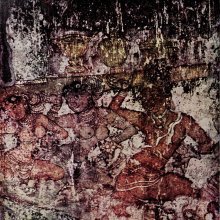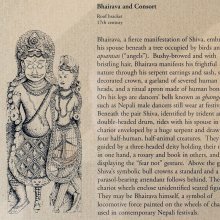Apsarasa, Apsarasā: 5 definitions
Introduction:
Apsarasa means something in Buddhism, Pali, Hinduism, Sanskrit. If you want to know the exact meaning, history, etymology or English translation of this term then check out the descriptions on this page. Add your comment or reference to a book if you want to contribute to this summary article.
Images (photo gallery)
In Hinduism
Natyashastra (theatrics and dramaturgy)
Source: Wisdom Library: Nāṭya-śāstraApsarasa (अप्सरस) is the Sanskrit name for a group of deities to be worshipped during raṅgapūjā, according to the Nāṭyaśāstra 3.1-8. Accordingly, the master of the dramatic art who has been initiated for the purpose shall consecrate the playhouse after he has made obeisance (e.g., to Apsarasas).

Natyashastra (नाट्यशास्त्र, nāṭyaśāstra) refers to both the ancient Indian tradition (shastra) of performing arts, (natya—theatrics, drama, dance, music), as well as the name of a Sanskrit work dealing with these subjects. It also teaches the rules for composing Dramatic plays (nataka), construction and performance of Theater, and Poetic works (kavya).
In Buddhism
Tibetan Buddhism (Vajrayana or tantric Buddhism)
Source: academia.edu: The Structure and Meanings of the Heruka MaṇḍalaApsarasā (अप्सरसा) is the name of a Ḍākinī who, together with the Vīra (hero) named Apsarasa forms one of the 36 pairs situated in the Jñānacakra, according to the 10th century Ḍākārṇava chapter 15. Accordingly, the jñānacakra refers to one of the three divisions of the saṃbhoga-puṭa (‘enjoyment layer’), situated in the Herukamaṇḍala. The 36 pairs of Ḍākinīs [viz., Apsarasā] and Vīras are white in color; the shapes of their faces are in accordance with their names; they have four arms; they hold a skull bowl, a skull staff, a small drum, and a knife.

Tibetan Buddhism includes schools such as Nyingma, Kadampa, Kagyu and Gelug. Their primary canon of literature is divided in two broad categories: The Kangyur, which consists of Buddha’s words, and the Tengyur, which includes commentaries from various sources. Esotericism and tantra techniques (vajrayāna) are collected indepently.
Languages of India and abroad
Sanskrit dictionary
Source: Cologne Digital Sanskrit Dictionaries: Monier-Williams Sanskrit-English Dictionary1) Āpsarasa (आप्सरस):—[from āpsara] mf(ī)n. a descendant of an Apsaras, [Bhāgavata-purāṇa vi, 4, 16]
2) [v.s. ...] n. Name of a Sāman.
[Sanskrit to German]
Sanskrit, also spelled संस्कृतम् (saṃskṛtam), is an ancient language of India commonly seen as the grandmother of the Indo-European language family (even English!). Closely allied with Prakrit and Pali, Sanskrit is more exhaustive in both grammar and terms and has the most extensive collection of literature in the world, greatly surpassing its sister-languages Greek and Latin.
See also (Relevant definitions)
Starts with: Apsarasagana.
Ends with: Pancapsarasa.
Full-text (+65): Apsaras, Apsarapati, Apsarastirtha, Apsarahpati, Manjughosha, Manobhava, Madanapriya, Klanda, Shobhavati, Ayushmatya, Mrigava, Gandharvapsaras, Manorama, Subhumika, Sparshananda, Shvavati, Bhirava, Varhaya, Upadevata, Vaditroka.
Relevant text
Search found 17 books and stories containing Apsarasa, Apsarasā, Āpsarasa; (plurals include: Apsarasas, Apsarasās, Āpsarasas). You can also click to the full overview containing English textual excerpts. Below are direct links for the most relevant articles:
Rig Veda (translation and commentary) (by H. H. Wilson)
Women in the Atharva-veda Samhita (by Pranab Jyoti Kalita)
2. Goddess Apsarases < [Chapter 4 - Female Deities and the Glorification of Women in the Atharvaveda]
6c. Hymns to Arouse the Passionate Love of a Woman < [Chapter 2 - The Strīkarmāṇi Hymns of the Atharvaveda]
The Curse of Urvasi < [June 1946]
Asvaghosha < [April – June, 2002]
"Prabhu Devara Ragale" < [April 1940]
Garga Samhita (English) (by Danavir Goswami)
Verse 4.19.77 < [Chapter 19 - A Thousand Names of Srī Yamunā]
Verse 6.1.33 < [Chapter 1 - Jarāsandha’s Defeat]
Verse 4.15.3 < [Chapter 15 - The Story of the Women of Barhiṣmatī-pura, the Apsarās, and the Women of Sutala and Nāgendra]
The Vishnu Purana (by Horace Hayman Wilson)
Chapter XXI - Families of the Daityas < [Book I]
Chapter X - Names of the twelve Adityas < [Book II]
Chapter IX - Legend of Lakshmi < [Book I]
Natyashastra (English) (by Bharata-muni)

